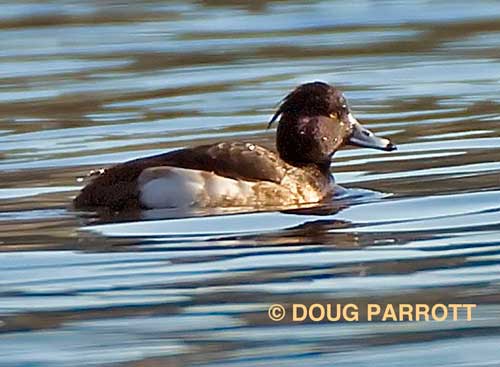On those rare winter days in Seattle when the sun shines, I like to get out to East Point to watch the dawn slowly light up the world. If the horizon is clear, you can see the first tinge of light shine on the top of Mount Rainier, then slide gently down its snowy sides in shades of pink, lavender, and gold until the entire mountain glows with unearthly color. The cold, still air of February presses down on the waters of the bay, smoothing the waves into glass, etched here and there by the ducks paddling by who leave behind only ripples and vees to mark their passage.
Such a morning arrived six days ago, and at 7:00 a.m., there I sat at East Point, drinking in great gulps of glory. As the light grew stronger, my friend Mark Vernon shimmered into view. Mark is famous as the Long Walker birder, a guy who thinks nothing of strolling from Montlake Fill to Volunteer Park, birding his way to heaven without the benefit of car. Mark is a very peaceful, centered kind of guy, the perfect zen-ish sort with whom to share such a morning.
So there we were, watching the ducks float by, watching the sun rise higher, trading stories about birds, when all of a sudden, Mark says I shot up from my stool and began jumping up and down shouting gibberish, of which the only two words he could make out were, “Tufted Duck!”
Tufted Ducks are a kind of mussel-eating, fishing duck from Eurasia. They belong to the scaup family and closely resemble both our own scaup, Greater and Lesser. The males of our native species have black heads and chests, gray backs, and pale flanks. They always look very tailored to me, like little businessmen dressed for success. I would not be all that surprised to see them someday with a tiny briefcase tucked under a wing, and a heavy schedule of appointments. But the Tufted Duck is different from our own more buttoned-down scaup — he has a streamer of feathers sprouting from his crown and flowing down his neck. Picture a middle-aged rock star with receding hairline and a long mullet preserving his illusion of youth, dressed in a suit because he has to appear in court for some infraction — that’s the human equivalent of a Tufted Duck. A bird with attitude.
Tufted Ducks are rare at the Fill. In the past 117 years, since birding records have been kept, only one has ever been seen here before. Statewide, we’ve had only about 50 since record-keeping began. Tufted Ducks don’t belong here. Their true home is Asia, Europe, and Africa. Whenever a Tufted Duck appears on our shores, it means the bird has wandered far off course.
That’s why, when I glanced down at the scaup paddling serenely past the point, almost within touching distance, and I saw his little tuft arch out like a banner, I literally could not believe my eyes. What I was shouting so incoherently to Mark was, “Oh my goodness, oh my goodness, oh my goodness, a Tufted Duck, oh my goodness.” Because I was stuttering with excitement, it came out sounding like, “OHMAgans, OHMAgans, OHMAgans.”
Mark must have thought I was chanting the latest in yoga meditation, until he realized no yoga acolyte would hop around as vigorously as I was. Then the words “Tufted Duck” smote his ears and he realized it was just a birder finding the greatest bird she ever saw. I think I’m in love.
(The Tufted Duck continues to enthrall his fans. He’s best found in the early morning off East Point, eating his mussel breakfast.)

